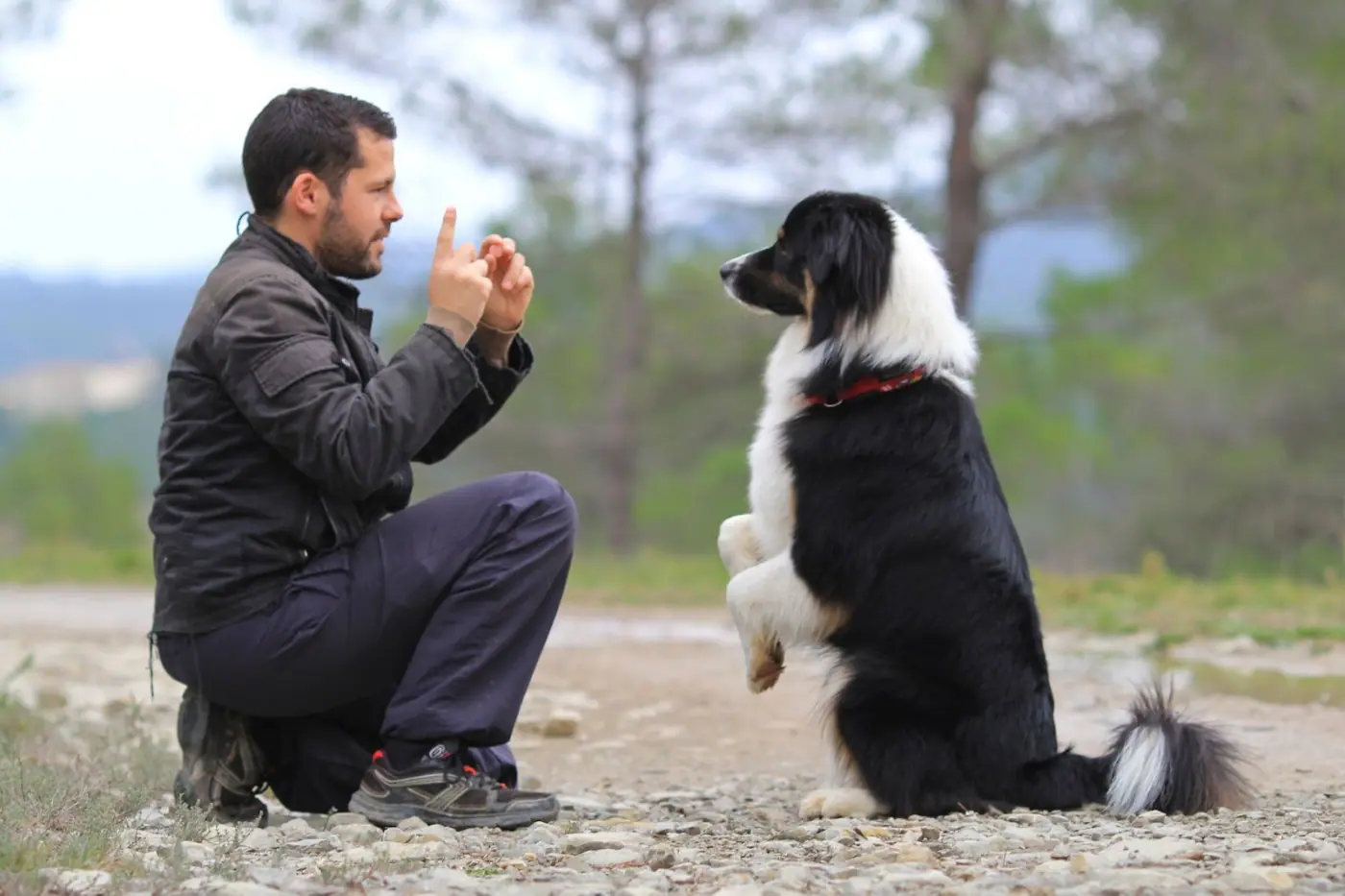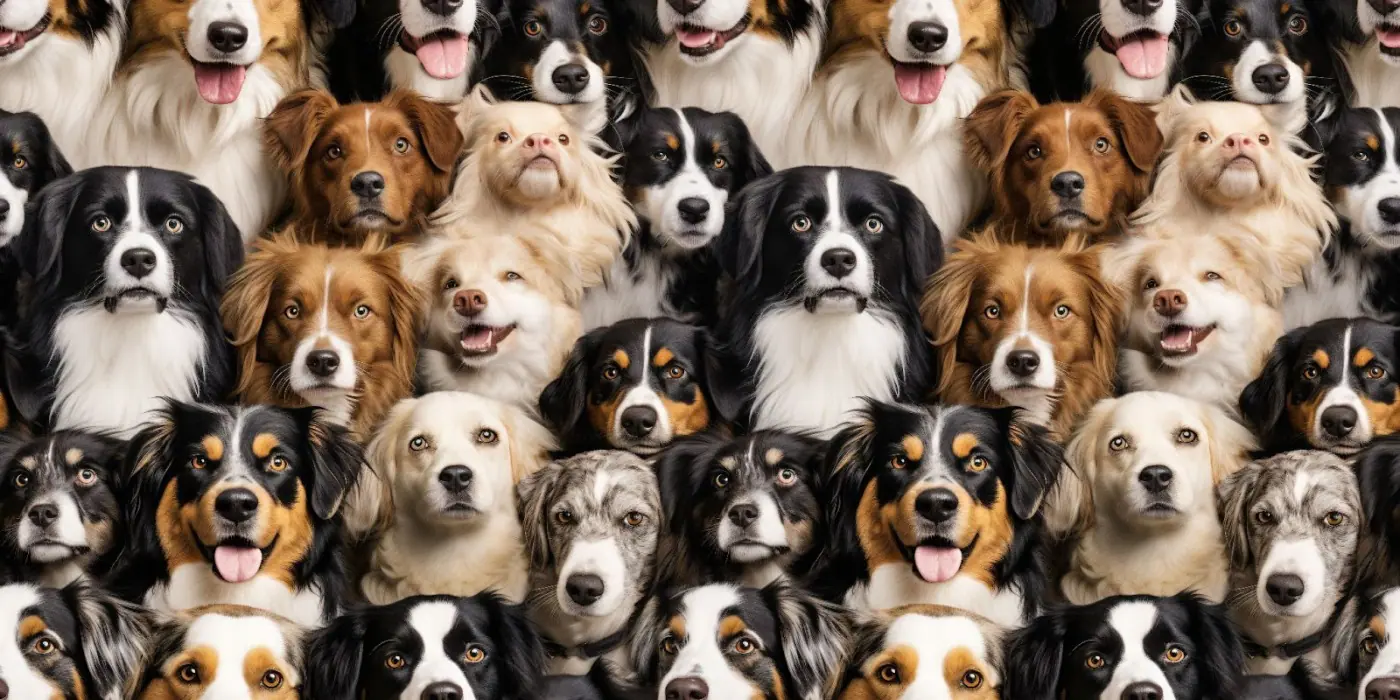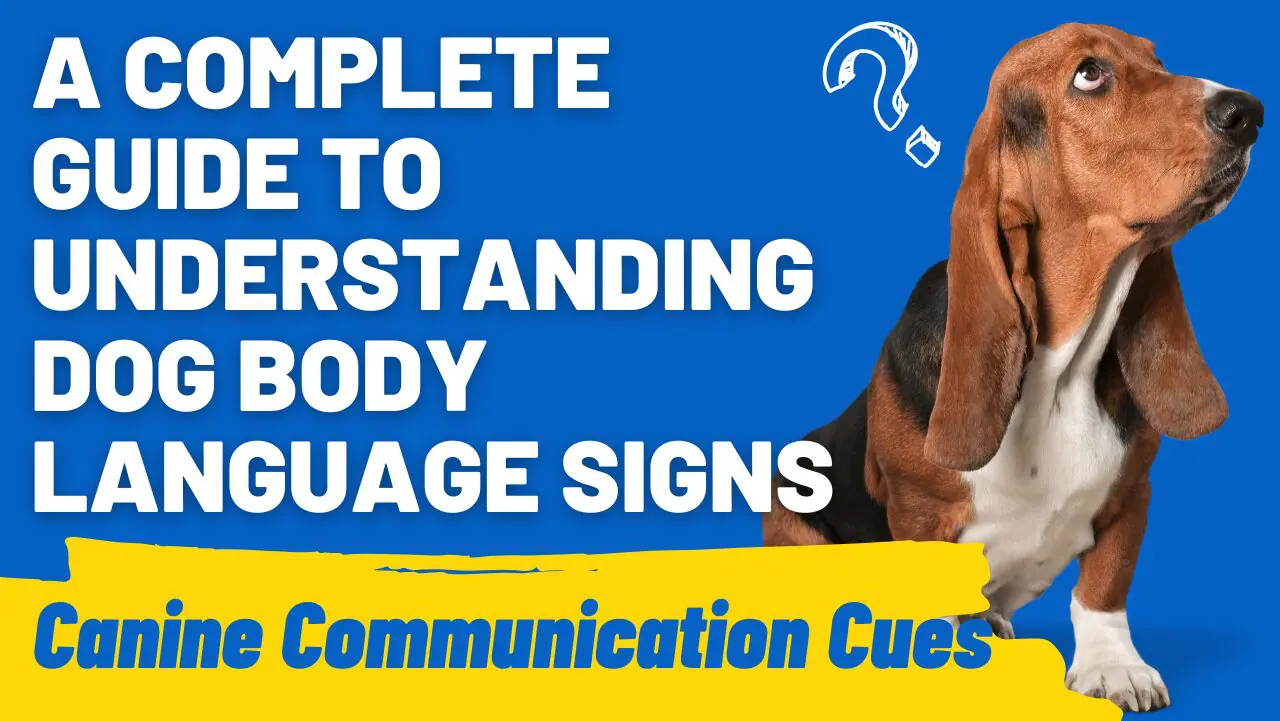Canine Communication Cues: A Complete Guide to Understanding Dog Body Language Signs
Dog body language signs are the secret code to understanding our four-legged companions’ thoughts and emotions.
As passionate dog lovers, we all relish those moments when our furry friends communicate through subtle cues and gestures. Understanding these nonverbal communication signals is fundamental to deepening the unspoken bond between us and our dogs.
In this comprehensive guide, we’ll embark on an enlightening journey to decipher the nuanced world of dog body language signs. Let’s delve into the fascinating realm of canine communication together.
Why is Understanding Dog Body Language Important?

Understanding dog body language signs is essential in the relationship between dogs and their human companions. This understanding isn’t merely about interpreting wagging tails or twitching ears but bridging the communication gap between our two species.
By deciphering dog body language signs, we gain profound insights into our furry friends’ emotions, intentions, and needs. This comprehension significantly enhances the bond between dogs and their owners, fostering trust, empathy, and mutual understanding.
Imagine being able to discern when your dog feels anxious, excited, or content simply by observing their body language. This ability doesn’t just enrich the connection; it empowers us to respond appropriately to our furry companions’ needs.
Whether recognizing signs of discomfort during a veterinary visit or understanding when they seek affection or solitude, being fluent in dog body language enables us to be better caregivers and companions to our beloved pets. Thus, it’s not merely about understanding their gestures; it’s about nurturing a deeper, more fulfilling relationship based on empathy and understanding.
You should read our newest post, Positive Dog Training: Tips and Techniques for Encouraging Good Behavior, it’s very insightful!
Decoding Basic Dog Body Language Signs
Understanding dog body language signs is akin to learning a new language that our furry companions use to communicate their feelings and thoughts.
This section will explore the fundamental aspects of dog body language, providing a crucial foundation for dog owners to effectively interpret their pets’ nonverbal cues.
Dogs express themselves through a myriad of cues, and by understanding these basic signs, owners can navigate their pets’ emotions more intuitively. Tail wagging, ear positioning, body posture, and facial expressions are among the primary forms of communication in the canine world.
Table: Key Dog Body Language Signs and Their Meanings
| Dog Body Language Signs | Typical Meanings |
| Tail Position | Up and wagging: Happy or excited |
| Tucked between legs: Anxious or fearful | |
| Ear Orientation | Perked up: Alert and attentive |
| Flattened back: Fearful or submissive | |
| Posture | Relaxed: Content or playful |
| Stiff and tense: Uncomfortable or stressed | |
| Facial Expressions | Relaxed mouth and eyes: Calm and content |
| Wrinkled forehead and bared teeth: Aggressive |
Understanding these basic dog body language signs lays the groundwork for a more profound connection between owners and their canine companions. It empowers owners to respond empathetically to their dogs’ needs and emotions, fostering a more harmonious and fulfilling relationship based on mutual understanding and trust.
Understanding Dog Gestures and What They Mean

Dogs are masterful communicators, expressing themselves through body language and an array of gestures that convey their feelings, needs, and intentions.
This section will delve into the diverse world of dog gestures, decoding their meanings and shedding light on what these actions signify in the canine lexicon.
Common Gestures and Their Interpretations
-
- Paw Lifting: Often, when a dog raises a paw, it’s a way of seeking attention or signaling a desire to play. Sometimes, it can also indicate discomfort or injury, prompting a need for reassurance or veterinary attention.
-
- Rolling Over: When a dog rolls onto its back, it can convey submission, trust, or an invitation to play. However, context matters – in certain situations, it might indicate a display of vulnerability or a request for a belly rub.
-
- Head Tilting: This endearing gesture often accompanies curiosity or attentiveness. Dogs might tilt their heads to understand sounds better or to express interest in something unfamiliar.
Gestures as Indicators of Mood
Understanding dog gestures goes beyond recognizing specific actions; it’s about discerning the emotions behind these gestures.
-
- Playfulness: Dogs exhibit a bouncy gait and wagging tails and might engage in the playful bow – front end lowered, hind end up – indicating their desire for interaction.
-
- Anxiety or Stress: A dog might exhibit lip licking, yawning, or avoiding eye contact when feeling stressed or anxious in a particular situation.
-
- Submission or Fear: Crouching low, tucking the tail, and avoiding direct eye contact are typical signs of submission or fear, often seen when a dog feels threatened or uncertain.
Each gesture is a piece of the puzzle that, when pieced together, forms a comprehensive understanding of a dog’s mood and emotional state. Interpreting these gestures enables owners to respond appropriately, providing comfort or support when needed and fostering a secure and trusting environment for their furry companions.
The Role of Dog Nonverbal Cues in Canine Communication
Understanding canine communication hinges on grasping the intricate realm of dog nonverbal cues.
This section uncovers the silent language that forms the basis of communication among dogs and highlights the significance of these cues in their interactions.
Understanding Silence and Stillness
-
- Silence Speaks Volumes: Silence is a powerful tool in dog communication. Dogs often convey messages through silence, indicating comfort, wariness, or contemplation.
-
- Interpreting Stillness: Dogs use stillness as a means of communication. A calm and unmoving posture can signal relaxation or attentiveness, whereas sudden stillness might indicate alertness or caution.
The Importance of Eye Contact
-
- Different Eye Contact Meanings: Eye contact is essential in canine communication. Direct, prolonged eye contact might convey dominance or aggression, while soft, brief gazes often signify trust or affection.
-
- Silent Signals: Dogs communicate silently through eye contact, using it to convey intentions, establish connections, or express emotions without vocalizing.
Understanding these dog nonverbal cues deepens our comprehension of canine communication. Dogs rely on these nonverbal signals as a primary mode of interaction, allowing owners to connect with their pets profoundly, building trust, and strengthening the human-canine bond.
Interpreting Dog Body Signs in Different Scenarios
Mastering the art of Interpreting dog body signs is fundamental for understanding our furry companions’ emotions and needs in various situations.
This section offers valuable guidance on deciphering dog body language across various scenarios, enabling owners to connect more deeply with their pets.
Interpreting Dog Body Signs During Different Scenarios:
-
- During Play: Dogs exhibit specific body language cues during playtime, such as loose, wiggly body posture, bouncy movements, and frequent play bows. Understanding these signals helps differentiate playful behavior from aggression or stress.
-
- While Resting: When dogs are at rest, their body language reflects relaxation and comfort. They may assume relaxed postures, lie on their sides or backs, and display slow, rhythmic breathing, indicating contentment and a sense of security.
-
- In New Environments: Dogs may show signs of apprehension or curiosity when introduced to unfamiliar surroundings. Look for behaviors like cautious movements, lowered body postures, sniffing, or pricked ears, indicating their attempt to assess and adapt to the new environment.
-
- During Training Sessions: Dogs communicate their engagement or disinterest in training through body language. A focused, attentive dog displays forward-facing ears, maintained eye contact, and an eagerness to comply, while disinterest may be signaled by yawning, turning away, or avoiding commands.
-
- In Social Settings: Body language cues play a crucial role when interacting with other dogs or people. Dogs may exhibit signals like sniffing, tail wagging, relaxed body postures, or playful barking to express their comfort or discomfort in social situations.
-
- In Stressful Situations: Stressful situations can trigger distinct body language signs such as panting, trembling, lowered body posture, or lip licking. Recognizing these signals helps alleviate stress and provide reassurance to the dog.
Understanding these dog body signs across different scenarios and introducing interactive toys like our All-in-one Puppy Toy Mat, designed to alleviate stress and engage dogs’ senses, empowers owners to interpret their pets’ emotions accurately, foster improved communication, and better care for their furry companions.
Understanding Dog Facial Expressions and What They Convey

Delving into dog facial expressions unveils a rich tapestry of emotions and intentions our furry friends communicate through their faces.
This section focuses on deciphering the intricate language of canine facial cues, providing insights into understanding the emotions dogs convey through their expressions.
The following are some of dog facial expressions and their meanings:
-
- Relaxed Face: Relaxed facial muscles, soft eyes, and a slightly open mouth usually indicate contentment, ease, or a relaxed state of mind.
-
- Raised Eyebrows: Raised eyebrows or a furrowed forehead might signify curiosity, concern, or an attempt to understand something unfamiliar.
-
- Tightened Face: A tense or tight facial expression, often accompanied by a closed mouth and narrowed eyes, might indicate discomfort, stress, or anxiety.
-
- Lip Licking/Yawning: Dogs might lick their lips or yawn as stress-relieving behaviors, indicating unease or discomfort in a situation.
-
- Show of Teeth: Baring teeth, often accompanied by a wrinkled muzzle, usually signals aggression, fear, or discomfort.
-
- Playful Expressions: A relaxed, open-mouthed smile or a playful expression with raised cheeks often signifies a desire for play or friendliness.
Owners can gain deeper insights into their pets’ emotional states and respond accordingly by observing and comprehending dog facial expressions. It’s a language of emotions that, when understood, fosters a stronger bond and enables better care for our beloved canine companions.
Tail Wagging Meanings: Not Just Happiness
Tail wagging is a universal symbol of a dog’s emotions, yet it’s a nuanced language often misunderstood.
This section delves deeper into the complexities of tail wagging, shedding light on its diverse meanings beyond just happiness. It clarifies that this behavior is a multifaceted form of communication, reflecting a spectrum of emotions.
Understanding Tail Wagging Meanings:
-
- Happiness and Excitement: A broad, high wag often indicates a dog’s happiness and excitement. It’s typically accompanied by a relaxed body, loose facial expressions, and sometimes, even a wagging body.
-
- Anxiety or Stress: Contrary to popular belief, a slow or low tail wag might denote anxiety, nervousness, or stress. Dogs experiencing discomfort or uncertainty might exhibit this type of wag, often accompanied by tense body language or a tucked tail.
-
- Alertness or Anticipation: Dogs can also wag their tails rapidly while holding their bodies stiffly, signaling alertness or anticipation. This kind of wag could occur when a dog is focused, assessing a new environment, or anticipating something, such as mealtime or play.
-
- Submission or Appeasement: A low and slow wag, significantly when the dog lowers its body, might convey submission or an attempt to appease a more dominant individual, whether it’s another dog or a person.
-
- Agitation or Aggression: A high, stiff wag with an erected tail could signify agitation, assertiveness, or even potential aggression. This wag, often accompanied by a stiff body or raised hackles, might indicate a dog’s discomfort or readiness to assert dominance.
Interpreting tail wagging involves considering the context, speed, height, and accompanying body language to grasp the valid message behind a dog’s wag. By understanding these nuances, pet owners can better comprehend their dog’s emotional state and respond appropriately, ensuring it feels understood, safe, and supported in various situations.
Canine Posture Analysis: Understanding Body Positioning
Canine posture analysis involves decoding the intricate language of a dog’s body positioning, unveiling the emotions, thoughts, and intentions conveyed through their physical stance.
This section delves deeply into the significance of different body positions in interpreting a dog’s feelings and underlying motivations.
Exploring Canine Posture Analysis:
-
- Confidence and Assertiveness: A dog standing tall with an erect posture, head held high, and a straight tail typically signifies confidence, assertiveness, or readiness to engage.
-
- Submissiveness or Anxiety: Lowering the body, tucking the tail, or crouching often indicates submissiveness, fear, or discomfort in a situation, highlighting a need for reassurance or safety.
-
- Relaxation and Comfort: A dog lying on its side or back muscles relaxed, often with exposed belly or limbs, demonstrates a state of relaxation, trust, and feeling secure.
-
- Readiness for Play: A forward-leaning stance, bouncy movements, and a lowered front end often suggest a playful mood and readiness to engage in playful activities.
-
- Alertness or Tension: A stiffened body, with muscles tensed, and a heightened state of awareness signifies alertness or tension, possibly indicating readiness to react or a response to a perceived threat.
By decoding canine postures, owners gain profound insights into their dog’s emotional states and intentions. Understanding these body positions enables owners to adapt their responses, providing appropriate support, comfort, or engagement to cater to their dog’s needs and emotional well-being.
Conclusion
Understanding dog body language is the cornerstone of a profound bond between humans and their canine companions. This knowledge isn’t just about communication; it’s the key to building empathy, trust, and a deeper connection.
By interpreting dog body language, owners create a stronger relationship with their pets, transcending language barriers. This understanding allows for intuitive responses to their dog’s needs, fostering a harmonious environment.
Highlighting the importance of interpreting dog body language, it’s clear that this skill enables tailored care and emotional support. It ensures dogs feel understood, safe, and cherished in their homes.
Ultimately, this understanding creates a partnership, establishing mutual respect and emotional connection. It’s the silent language that enriches our lives and enhances the well-being of our furry friends.
FAQs about Dog Body Language Signs
Can dog body language vary from one breed to another?
While certain behaviors might be universal, the interpretation of dog body language can vary among breeds. Observing and understanding your dog’s unique gestures and cues is essential to interpret their emotions accurately.
What should I do if I’m unsure about my dog’s body language signals?
If you’re uncertain about your dog’s body language or behavior, seek advice from a qualified veterinarian, dog behaviorist, or trainer. They can offer guidance and help you better understand and address your dog’s needs.
Can dogs use body language to communicate with other animals or pets?
Yes, dogs use body language to communicate with humans and interact with other dogs and animals. Understanding these cues helps in ensuring peaceful interactions among pets and fosters positive socialization.
Explore, Learn, and Bond: Elevate Your Canine Connection with HoundGames!
Are you eager to strengthen the unspoken bond with your canine companion? At HoundGames, we don’t just offer a range of interactive toys. We’re here to empower and educate dog owners like you!
Gain a deeper understanding of your dog’s communication through our comprehensive guide to interpreting their body language. With this knowledge, explore our diverse array of products meticulously designed to enrich your dog’s life and relationship.
Discover innovative toys that stimulate their minds and bodies, encourage positive behavior, are high-quality, and ensure comfort and safety. Our mission is to support you on your journey as a dog parent, making each moment with your furry friend an adventure.
Visit HoundGames today and embark on a fulfilling experience where education meets fun for both you and your beloved dog!

